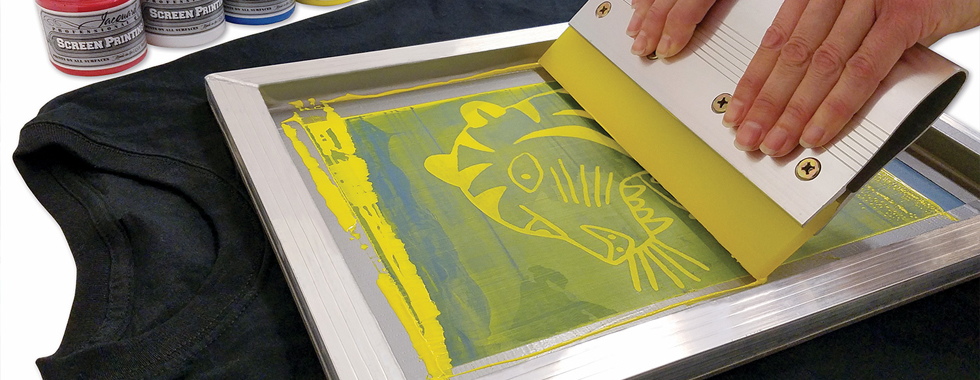ChatGPT said: Inside look at 10:9 Design LLC Company screen printing process
The Necessary Guide to Comprehending Screen Printing and Its Versatile Uses
Screen printing has an abundant history that goes back to old times, progressing right into an advanced technique used throughout various sectors today. This overview discovers the ins and outs of the screen printing procedure, describing its applications in style, marketing, and home design - 10:9 Design near me. Recognizing these fundamentals can open imaginative potential for both commercial and artistic jobs. The following sections will disclose essential pointers and methods to enhance one's screen printing undertakings
The History of Screen Printing
Although screen printing has roots that map back centuries, its evolution shows the technical and artistic innovations of different cultures. Coming from ancient China, the strategy was initially made use of for decorating textiles and later infect Japan, where it ended up being integral to Ukiyo-e woodblock printing. The method shifted to Europe in the 18th century, where it gained popularity amongst craftsmens and industrial printers. The creation of picture solution in the 20th century transformed screen printing, permitting more complex designs and better efficiency. Artists like Andy Warhol better thrust its appeal, making use of the tool to produce famous jobs that blended commercialism and great art. By the late 20th century, screen printing had established itself as a flexible method, used in fashion, marketing, and art. Today, it remains to evolve, incorporating digital technology and increasing its applications across various industries.
The Screen Printing Process Explained
Screen printing transforms imaginative visions right into substantial styles through a series of precise steps. A photo is created and after that transferred onto a screen, typically made of fine mesh fabric stretched over a framework. A light-sensitive emulsion is used to the screen, which is exposed to light, solidifying in locations not covered by the picture. After cleaning out the unhardened emulsion, a pattern is developed.
Next, the screen is placed over the substrate, whether it be material, paper, or another material. Ink is then pressed via the open areas of the stencil using a squeegee, transferring the design onto the substratum listed below. This process can be repeated for several colors, requiring separate displays for each and every color. Ultimately, the printed thing is healed using warmth to assure the ink adheres correctly, leading to a resilient, dynamic design prepared for use.
Sorts Of Screen Printing Techniques

In look at here now addition, specialized strategies, such as discharge screen printing, eliminate dye from the fabric to develop softer prints, while aluminum foil screen printing uses metallic foil to achieve a shiny coating (10:9 Design Screen Printing). Each technique provides unique attributes, accommodating various imaginative requirements and manufacturing ranges, eventually expanding the opportunities within the screen printing domain
Applications of Screen Printing in Different Industries

In addition, the signs and marketing sectors use screen printing for producing distinctive displays and banners. This technique enables bold shades and elaborate designs that capture focus. In electronics, screen printing is used for using conductive inks to motherboard, vital for component connections. The home design sector embraces screen printing to produce unique layouts on fabrics and wall surface art. Overall, screen printing offers as a critical tool throughout varied fields, boosting products with individualized and visually enticing graphics.
Tips for Effective Screen Printing Projects
While taking on a screen printing task, cautious interest to detail can considerably enhance the final outcome. Picking top quality products is important; this includes the screen, inks, and substrates. Utilizing ideal mesh matters can affect ink deposition and detail resolution. Prep work is similarly essential; detailed cleaning of screens and correct direct exposure times assure crisp prints.
Next, accurate enrollment is important for multi-color prints. Utilizing placement tools can help achieve accurate layering. In addition, testing prints on scrap materials before production assists identify potential problems without losing sources.
.png)
Frequently Asked Inquiries
What Materials Are Ideal for Screen Printing on Material?
Cotton and polyester blends are optimal for screen printing on material as a result of their sturdiness and ink absorption. Furthermore, specialized materials like silk or canvas can produce unique appearances and coatings, enhancing the total style high quality.
Exactly how Do I Tidy and Maintain Screen Printing Equipment?
To preserve and cleanse screen printing equipment, one must consistently custom sign printing near me clean displays with ideal solvents, inspect mops for wear, lube relocating components, and shop all things in a completely dry, dust-free setting to lengthen their life expectancy.
What Are the Ecological Effects of Screen Printing?
Screen printing can have significant ecological influences, consisting of chemical waste from inks and solvents, water usage throughout cleaning processes, and energy consumption. Eco-friendly materials and lasting techniques are essential for decreasing these adverse results.
Can Screen Printing Be Done in the house Successfully?
Screen printing can be properly done at home with the ideal products and strategies. Hobbyists can create top quality prints, though success depends upon their ability degree, devices, and understanding of the procedure entailed.
What Are the Costs Linked With Starting a Screen Printing Service?

Beginning a screen printing company involves prices for equipment, products, and workspace. First costs commonly range from a few hundred to a number of thousand dollars, relying on the range, high quality of machinery, and wanted manufacturing capacity.
Screen printing has a rich history that dates back to ancient times, progressing right into an innovative technique utilized across different sectors today. Another technique, rotary screen printing, uses cylindrical screens, assisting in constant printing on fabric rolls, thus enhancing effectiveness for large-scale manufacturings. In addition, specialized techniques, such as discharge screen printing, eliminate dye from the material to produce softer prints, while aluminum foil screen printing uses metal aluminum foil to attain a glossy coating. In the style sector, screen printing is widely used to create vivid layouts on apparel, allowing brands to showcase their one-of-a-kind styles. Cotton and polyester blends are optimal for screen printing on material due to their toughness and ink absorption.